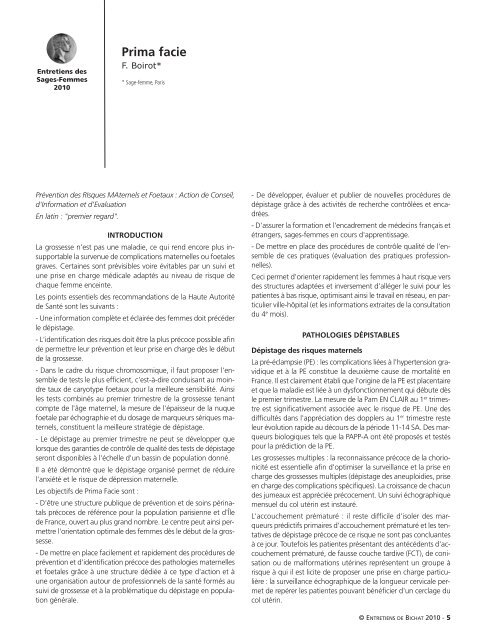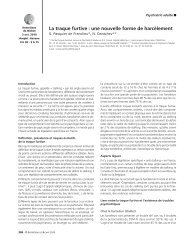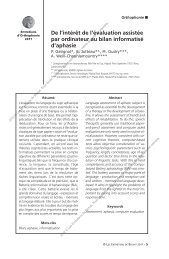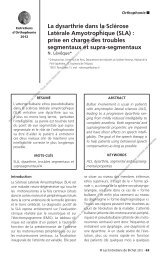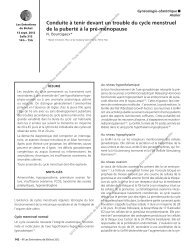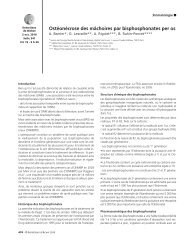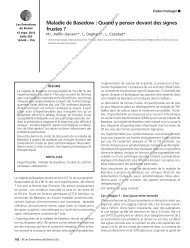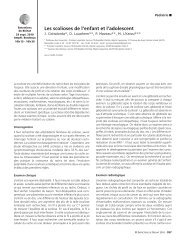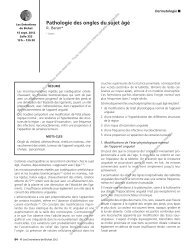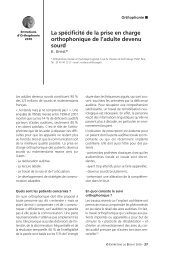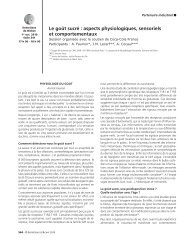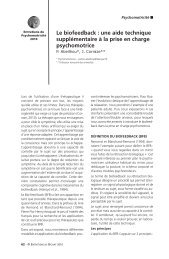Prima facie - Les entretiens de Bichat
Prima facie - Les entretiens de Bichat
Prima facie - Les entretiens de Bichat
You also want an ePaper? Increase the reach of your titles
YUMPU automatically turns print PDFs into web optimized ePapers that Google loves.
Entretiens <strong>de</strong>s<br />
Sages-Femmes<br />
2010<br />
<strong>Prima</strong> <strong>facie</strong><br />
F. Boirot*<br />
* Sage-femme, Paris<br />
Prévention <strong>de</strong>s RIsques MAternels et Foetaux : Action <strong>de</strong> Conseil,<br />
d'Information et d'Evaluation<br />
En latin : "premier regard".<br />
INTRODUCTION<br />
La grossesse n'est pas une maladie, ce qui rend encore plus insupportable<br />
la survenue <strong>de</strong> complications maternelles ou foetales<br />
graves. Certaines sont prévisibles voire évitables par un suivi et<br />
une prise en charge médicale adaptés au niveau <strong>de</strong> risque <strong>de</strong><br />
chaque femme enceinte.<br />
<strong>Les</strong> points essentiels <strong>de</strong>s recommandations <strong>de</strong> la Haute Autorité<br />
<strong>de</strong> Santé sont les suivants :<br />
- Une information complète et éclairée <strong>de</strong>s femmes doit précé<strong>de</strong>r<br />
le dépistage.<br />
- L'i<strong>de</strong>ntification <strong>de</strong>s risques doit être la plus précoce possible afin<br />
<strong>de</strong> permettre leur prévention et leur prise en charge dès le début<br />
<strong>de</strong> la grossesse.<br />
- Dans le cadre du risque chromosomique, il faut proposer l'ensemble<br />
<strong>de</strong> tests le plus efficient, c'est-à-dire conduisant au moindre<br />
taux <strong>de</strong> caryotype foetaux pour la meilleure sensibilité. Ainsi<br />
les tests combinés au premier trimestre <strong>de</strong> la grossesse tenant<br />
compte <strong>de</strong> l'âge maternel, la mesure <strong>de</strong> l'épaisseur <strong>de</strong> la nuque<br />
foetale par échographie et du dosage <strong>de</strong> marqueurs sériques maternels,<br />
constituent la meilleure stratégie <strong>de</strong> dépistage.<br />
- Le dépistage au premier trimestre ne peut se développer que<br />
lorsque <strong>de</strong>s garanties <strong>de</strong> contrôle <strong>de</strong> qualité <strong>de</strong>s tests <strong>de</strong> dépistage<br />
seront disponibles à l'échelle d'un bassin <strong>de</strong> population donné.<br />
Il a été démontré que le dépistage organisé permet <strong>de</strong> réduire<br />
l'anxiété et le risque <strong>de</strong> dépression maternelle.<br />
<strong>Les</strong> objectifs <strong>de</strong> <strong>Prima</strong> Facie sont :<br />
- D'être une structure publique <strong>de</strong> prévention et <strong>de</strong> soins périnatals<br />
précoces <strong>de</strong> référence pour la population parisienne et d'Île<br />
<strong>de</strong> France, ouvert au plus grand nombre. Le centre peut ainsi permettre<br />
l'orientation optimale <strong>de</strong>s femmes dès le début <strong>de</strong> la grossesse.<br />
- De mettre en place facilement et rapi<strong>de</strong>ment <strong>de</strong>s procédures <strong>de</strong><br />
prévention et d'i<strong>de</strong>ntification précoce <strong>de</strong>s pathologies maternelles<br />
et foetales grâce à une structure dédiée à ce type d'action et à<br />
une organisation autour <strong>de</strong> professionnels <strong>de</strong> la santé formés au<br />
suivi <strong>de</strong> grossesse et à la problématique du dépistage en population<br />
générale.<br />
- De développer, évaluer et publier <strong>de</strong> nouvelles procédures <strong>de</strong><br />
dépistage grâce à <strong>de</strong>s activités <strong>de</strong> recherche contrôlées et encadrées.<br />
- D'assurer la formation et l'encadrement <strong>de</strong> mé<strong>de</strong>cins français et<br />
étrangers, sages-femmes en cours d'apprentissage.<br />
- De mettre en place <strong>de</strong>s procédures <strong>de</strong> contrôle qualité <strong>de</strong> l'ensemble<br />
<strong>de</strong> ces pratiques (évaluation <strong>de</strong>s pratiques professionnelles).<br />
Ceci permet d'orienter rapi<strong>de</strong>ment les femmes à haut risque vers<br />
<strong>de</strong>s structures adaptées et inversement d'alléger le suivi pour les<br />
patientes à bas risque, optimisant ainsi le travail en réseau, en particulier<br />
ville-hôpital (et les informations extraites <strong>de</strong> la consultation<br />
du 4 e mois).<br />
PATHOLOGIES DÉPISTABLES<br />
Dépistage <strong>de</strong>s risques maternels<br />
La pré-éclampsie (PE) : les complications liées à l'hypertension gravidique<br />
et à la PE constitue la <strong>de</strong>uxième cause <strong>de</strong> mortalité en<br />
France. Il est clairement établi que l'origine <strong>de</strong> la PE est placentaire<br />
et que la maladie est liée à un dysfonctionnement qui débute dès<br />
le premier trimestre. La mesure <strong>de</strong> la Pam EN CLAIR au 1 er trimestre<br />
est significativement associée avec le risque <strong>de</strong> PE. Une <strong>de</strong>s<br />
difficultés dans l'appréciation <strong>de</strong>s dopplers au 1 er trimestre reste<br />
leur évolution rapi<strong>de</strong> au décours <strong>de</strong> la pério<strong>de</strong> 11-14 SA. Des marqueurs<br />
biologiques tels que la PAPP-A ont été proposés et testés<br />
pour la prédiction <strong>de</strong> la PE.<br />
<strong>Les</strong> grossesses multiples : la reconnaissance précoce <strong>de</strong> la chorionicité<br />
est essentielle afin d'optimiser la surveillance et la prise en<br />
charge <strong>de</strong>s grossesses multiples (dépistage <strong>de</strong>s aneuploidies, prise<br />
en charge <strong>de</strong>s complications spécifiques). La croissance <strong>de</strong> chacun<br />
<strong>de</strong>s jumeaux est appréciée précocement. Un suivi échographique<br />
mensuel du col utérin est instauré.<br />
L'accouchement prématuré : il reste difficile d'isoler <strong>de</strong>s marqueurs<br />
prédictifs primaires d'accouchement prématuré et les tentatives<br />
<strong>de</strong> dépistage précoce <strong>de</strong> ce risque ne sont pas concluantes<br />
à ce jour. Toutefois les patientes présentant <strong>de</strong>s antécé<strong>de</strong>nts d'accouchement<br />
prématuré, <strong>de</strong> fausse couche tardive (FCT), <strong>de</strong> conisation<br />
ou <strong>de</strong> malformations utérines représentent un groupe à<br />
risque à qui il est licite <strong>de</strong> proposer une prise en charge particulière<br />
: la surveillance échographique <strong>de</strong> la longueur cervicale permet<br />
<strong>de</strong> repérer les patientes pouvant bénéficier d'un cerclage du<br />
col utérin.<br />
© ENTRETIENS DE BICHAT 2010 - 5
L'utérus cicatriciel et l'anomalie <strong>de</strong> l'insertion placentaire : il est<br />
nécessaire <strong>de</strong> mettre en place <strong>de</strong>s procédures <strong>de</strong> dépistage prénatal<br />
du placenta accreta puisque la découverte per-partum <strong>de</strong><br />
celui-ci conduit à une morbidité plus sévère et à une augmentation<br />
<strong>de</strong> la mortalité.<br />
<strong>Les</strong> conduites addictives : une telle procédure peut permettre<br />
d'avoir un impact très positif en terme <strong>de</strong> santé publique.<br />
L'hémorragie <strong>de</strong> la délivrance : ce risque peut être en rapport avec<br />
une anomalie <strong>de</strong> la placentation ou <strong>de</strong> l'hémostase. Un antécé<strong>de</strong>nt<br />
est également à considérer comme un facteur <strong>de</strong> risque important<br />
et les thérapeutiques employées lors du premier épiso<strong>de</strong><br />
peuvent retentir sur la grossesse actuelle. Un antécé<strong>de</strong>nt doit donc<br />
être connu, explicité et éventuellement exploré dès le début <strong>de</strong> la<br />
grossesse suivante si cela n'a pas été fait avant.<br />
Le diabète gestationnel : le diabète dépisté précocement (avant<br />
16 SA) constitue le groupe à plus haut risque <strong>de</strong> complications<br />
materno-foetales. Un dépistage systématique chez les patientes<br />
à haut risque (antécé<strong>de</strong>nts familiaux <strong>de</strong> diabète, antécé<strong>de</strong>nts <strong>de</strong><br />
macrosomie ou d'acci<strong>de</strong>nt obstétrical compatible, obésité,<br />
âge > 35 ans, glycosurie) par un test unique à 75 grammes pourrait<br />
être évalué dès 14 SA.<br />
<strong>Les</strong> infections à transmission foetale potentielle : une évaluation<br />
spécifique <strong>de</strong> l'intérêt du dépistage <strong>de</strong> l'infection à CMV pendant<br />
la grossesse en France a été effectué par l'ANAES à partir <strong>de</strong>s données<br />
<strong>de</strong> la littérature et à confirmer l'absence <strong>de</strong> recommandation<br />
pour un dépistage systématique ou ciblé pendant la grossesse;<br />
cependant, un traitement administré pendant la grossesse peut<br />
diminuer les risques foetaux en cas <strong>de</strong> transmission materno-foetale.<br />
<strong>Les</strong> autres infections sont recherchées tel que cela est recommandé<br />
dans le suivi <strong>de</strong> la grossesse.<br />
Risque thrombotique et complications <strong>de</strong> la thrombophilie : il est<br />
important <strong>de</strong> dépister une hypercoagulabilité acquise surajoutée<br />
du fait du risque important <strong>de</strong> complications, en particulier <strong>de</strong><br />
complications vasculaires (HRP, MFIU, PE, mort néonatale). Il est<br />
également licite d'effectuer un dépistage systématique chez les<br />
patientes présentant au moins 3 FC du premier trimestre, ou 2 FC<br />
tardives, ou un antécé<strong>de</strong>nt <strong>de</strong> PE sévère et/ou précoce et/ou récidivante,<br />
ou encore un antécé<strong>de</strong>nt <strong>de</strong> RCIU sévère.<br />
Prise en charge psychologique : la visite au cours <strong>de</strong> laquelle est<br />
réalisée l'échographie du premier trimestre constitue une pério<strong>de</strong><br />
charnière pour le couple. C'est la matérialisation <strong>de</strong> l'enfant à naître<br />
qui débute. La notion <strong>de</strong> risque, la remise en question <strong>de</strong> l'enfant<br />
parfait, le risque maternel lié à la grossesse, la décision <strong>de</strong><br />
geste invasif potentiellement dangereux, l'attente <strong>de</strong> résultats<br />
sont autant d'éléments qui peuvent être générateurs d'anxiété,<br />
d'angoisse voire d'épiso<strong>de</strong>s dépressifs.<br />
Risque social : le risque <strong>de</strong> mort maternelle est <strong>de</strong>ux fois plus élevé<br />
chez les femmes qui ne sont pas originaires <strong>de</strong> l'Union Européenne<br />
(UE), nous renvoyant à <strong>de</strong>s questions d'égalité d'accès à<br />
la prévention et aux soins, notamment pour <strong>de</strong>s populations socialement<br />
vulnérables. Cette prise en charge pour permettre un<br />
meilleur suivi est réalisée en partenariat avec les centres <strong>de</strong> PMI.<br />
Dépistage <strong>de</strong>s risques foetaux<br />
Risque chromosomique : la trisomie 21 est la plus fréquente <strong>de</strong>s<br />
aneuploidies. La mise en place d'un programme <strong>de</strong> dépistage <strong>de</strong>s<br />
aneuploidies doit prendre en compte <strong>de</strong> nombreux paramètres. Il<br />
est fondamental d'encadrer les politiques <strong>de</strong> dépistage afin d'éviter<br />
toute dérive. <strong>Les</strong> étu<strong>de</strong>s permettent d'estimer le taux <strong>de</strong> dépistage<br />
6 © ENTRETIENS DE BICHAT 2010<br />
à plus <strong>de</strong> 85 % pour 5 % <strong>de</strong> faux positifs. En cas <strong>de</strong> risque élevé<br />
d'aneuploidie, un test diagnostic peut être réalisé dès 11-14 SA si<br />
la femme le souhaite sur prélèvement <strong>de</strong> villosités choriales.<br />
Risque malformatif : outre les anomalies anatomiques dépistables<br />
pouvant expliquer une hyperclarté nucale (malformations cardiaques,<br />
hernie <strong>de</strong> coupole diaphragmatique, dysplasies squelettiques,...),<br />
l'examen échographique permet également <strong>de</strong><br />
diagnostiquer les malformations cérébrales majeures (anencéphalie,<br />
holoprosencéphalie alobaire, méningocèle, encéphalocèle, hydranencéphalie,...),<br />
les défauts <strong>de</strong> fermeture du tube neural, les<br />
défauts <strong>de</strong> fermeture <strong>de</strong> la paroi abdominale, ainsi que <strong>de</strong>s anomalies<br />
rénales ou urinaires. Ainsi, on estime qu'au moins 50 %<br />
<strong>de</strong>s malformations majeures sont détectables dès le premier trimestre.<br />
L'avantage médical est très clair dans la population <strong>de</strong>s<br />
femmes ayant une cicatrice utérine chez qui une IMG tardive présente<br />
un risque majoré.<br />
Anomalies <strong>de</strong> la croissance foetale : le RCIU reste un pourvoyeur<br />
important <strong>de</strong> morbidité et <strong>de</strong> mortalité périnatale. Un certain nombre<br />
d'éléments peuvent permettre d'isoler, dès le 1er trimestre, un<br />
groupe à risque élevé <strong>de</strong> retard <strong>de</strong> croissance. <strong>Les</strong> patientes présentant<br />
un taux bas <strong>de</strong> PAPP-A (inférieur au 5ème percentile) auraient<br />
un risque 3 à 4 fois plus élevé d'accoucher d'un enfant hypotrophe.<br />
Ceci serait probablement le reflet d'anomalies <strong>de</strong> la placentation.<br />
Risques tératogènes : les substances potentiellement tératogènes<br />
ayant pu être consommées par la patiente sont recherchées lors<br />
<strong>de</strong> l'entretien initial. Un suivi peut être adapté en fonction <strong>de</strong>s<br />
données les plus récentes (www.lecrat.org).<br />
ORGANISATION DU PARCOURS DE SANTÉ<br />
Documents envoyés à la patiente lors <strong>de</strong> la prise <strong>de</strong> rdv<br />
Livret d'information : il comprend <strong>de</strong>s informations sur le dépistage<br />
« standard » qui lui est proposé, le fonctionnement du centre,<br />
ses intervenants, les protocoles <strong>de</strong> recherche en cours.<br />
Questionnaire médical : il permet d'établir les principaux antécé<strong>de</strong>nts<br />
et facteurs <strong>de</strong> risques, d'améliorer la prise en charge dès<br />
l'arrivée dans le centre. <strong>Les</strong> questions regroupent <strong>de</strong>s éléments<br />
sur les facteurs <strong>de</strong> risques médicaux, obstétricaux mais également<br />
sociaux ou psychologiques.Il s'agit uniquement <strong>de</strong> questions simples<br />
avec <strong>de</strong>s réponses à choix multiples ou <strong>de</strong> type oui/non.<br />
Prise en charge à <strong>Prima</strong> Facie<br />
Entretien et examen initial : il permet <strong>de</strong> compléter les renseignements<br />
du dossier administratif et médical grâce au questionnaire<br />
rempli par la femme. L'information sur la prise en charge et le dépistage<br />
est à nouveau détaillée et expliquée.<br />
L'examen général et gynécologique comprend entre autres et en<br />
fonction <strong>de</strong>s besoins, poids, taille, prise automatisée <strong>de</strong> la pression<br />
artérielle sanguine, prélèvement vaginal, ECBU... Le suivi gynécologique<br />
est réalisé en collaboration avec la sage-femme ou le gynécologue<br />
traitant habituel <strong>de</strong> la patiente.<br />
L'échographie : elle est réalisée selon les standards <strong>de</strong> soins (Comité<br />
National Technique <strong>de</strong> l'Échographie <strong>de</strong> Dépistage Prénatal<br />
2005) ; elle permet <strong>de</strong> vérifier le nombre d'embryons, la vitalité, la<br />
morphologie, la mesure <strong>de</strong> la clarté nucale. D'autres éléments peuvent<br />
être acquis en fonction <strong>de</strong>s antécé<strong>de</strong>nts et <strong>de</strong>s protocoles <strong>de</strong><br />
recherche en cours : insertion placentaire, mesure du col utérin...<br />
<strong>Les</strong> prélèvements sanguins : groupage sanguin avec rhésus et RAI,
sérologies infectieuses en fonction <strong>de</strong>s recommandations, marqueurs<br />
sériques maternels; une sérothèque est constituée. D'autres<br />
prélèvements peuvent être réalisés en fonction <strong>de</strong>s<br />
antécé<strong>de</strong>nts et <strong>de</strong>s protocoles <strong>de</strong> recherche en cours : examens<br />
d'hémostase ou <strong>de</strong> thrombophilie...<br />
Rendu <strong>de</strong> résultat<br />
<strong>Les</strong> résultats <strong>de</strong>s procédures <strong>de</strong> dépistage sont rendus le jour<br />
même ou <strong>de</strong> façon différée si la patiente le souhaite ainsi, au cours<br />
d'une consultation avec une sage-femme, ou avec un mé<strong>de</strong>cin<br />
en fonction <strong>de</strong>s résultats. <strong>Les</strong> résultats sont rendus et expliqués<br />
<strong>de</strong> manière orale et écrite sous la forme d'un rapport comprenant<br />
<strong>de</strong>s recommandations pour le suivi <strong>de</strong> la grossesse. Le rapport est<br />
immédiatement envoyé au correspondant <strong>de</strong> la patiente. Une<br />
consultation avec la psychologue est possible dans le même temps<br />
en cas d'annonce difficile.<br />
Prise en charge <strong>de</strong>s femmes à faible risque : dans l'immense majorité<br />
<strong>de</strong>s situations, l'ensemble <strong>de</strong>s examens cliniques, échographiques<br />
et biologiques sont rassurants. La femme peut alors être<br />
adressée avec les conseils d'usage pour un suivi habituel <strong>de</strong> sa<br />
grossesse.<br />
Prise en charge <strong>de</strong>s femmes à risque élevé : la femme est adressée<br />
pour un parcours <strong>de</strong> soins à une structure <strong>de</strong> niveau adapté à son<br />
niveau <strong>de</strong> risque augmenté.<br />
CONCLUSION<br />
L'ensemble <strong>de</strong>s issues <strong>de</strong> grossesse est collecté à l'ai<strong>de</strong> <strong>de</strong>s formulaires.<br />
L'ensemble <strong>de</strong>s procédures <strong>de</strong> dépistage est régulièrement<br />
évalué par l'équipe <strong>de</strong> <strong>Prima</strong> Facie ainsi que par un audit<br />
externe. C'est pourquoi une enquête <strong>de</strong> satisfaction <strong>de</strong>s patientes<br />
est déjà en cours révélant un taux encourageant <strong>de</strong> réponses positives<br />
relatives à leurs attentes.<br />
Cette prise en charge initiale par la sage-femme, en lien avec<br />
l'équipe pluridisciplinaire, laisse place à un espace d'échange et<br />
<strong>de</strong> réassurance et offre au couple et en particulier à la patiente,<br />
un déroulement plus serein <strong>de</strong> la grossesse, afin d'accueillir l'enfant<br />
en toute quiétu<strong>de</strong>.<br />
RÉFÉRENCES<br />
1 - AAP et ACOG, A. A. o. P. a. A. C. o. O. a. G. (2002). "Gui<strong>de</strong>lines for perinatal<br />
care." American College of Obstetricians et Gynecologists.: 90.<br />
2 - Alfirevic, Z., K. Sundberg et S. Brigham (2003). "Amniocentesis et chorionic<br />
villus sampling for prenatal diagnosis." Cochrane Database Syst Rev(3):<br />
CD003252.<br />
3 - Althuisius, S. M., G. A. Dekker, P. Hummel, D. J. Bekedam et H. P. van Geijn<br />
(2001). "Final results of the Cervical Incompetence Prevention Randomized<br />
Cerclage Trial (CIPRACT): therapeutic cerclage with bed rest versus bed rest<br />
alone." Am J Obstet Gynecol 185(5): 1106-12.<br />
4 - Althuisius, S. M., G. A. Dekker, H. P. van Geijn, D. J. Bekedam et P. Hummel<br />
(2000). "Cervical incompetence prevention randomized cerclage trial<br />
(CIPRACT): study <strong>de</strong>sign et preliminary results." Am J Obstet Gynecol 183(4):<br />
823-9.<br />
5 - Althuisius, S. M., G. A. Dekker, H. P. van Geijn et P. Hummel (1999). "The<br />
effect of therapeutic McDonald cerclage on cervical length as assessed by<br />
transvaginal ultrasonography." Am J Obstet Gynecol 180(2 Pt 1): 366-9.<br />
6 - Audibert, F. (2005). "Screening for pre-eclampsia: the quest for the Holy<br />
Grail?" Lancet 365(9468): 1367-9.<br />
7 - Audibert, F., Y. Benchimol, C. Benattar, C. Champagne et R. Frydman (2005).<br />
"Prediction of preeclampsia or intrauterine growth restriction by second<br />
trimester serum screening et uterine Doppler velocimetry." Fetal Diagn Ther<br />
20(1): 48-53.<br />
8 - Bartha, J. L., P. Martinez-Del-Fresno et R. Comino-Delgado (2000).<br />
"Gestational diabetes mellitus diagnosed during early pregnancy." Am J<br />
Obstet Gynecol 182(2): 346-50.<br />
9 - Bartha, J. L., P. Martinez-Del-Fresno et R. Comino-Delgado (2003). "Early<br />
diagnosis of gestational diabetes mellitus et prevention of diabetes-related<br />
complications." Eur J Obstet Gynecol Reprod Biol 109(1): 41-4.<br />
10 - Baumann, M. U., N. A. Bersinger et D. V. Surbek (2007). "Serum markers for<br />
predicting pre-eclampsia." Mol Aspects Med 28(2): 227-44.<br />
11 - Becker, R. et R. D. Wegner (2006). "Detailed screening for fetal anomalies<br />
et cardiac <strong>de</strong>fects at the 11-13-week scan." Ultrasound Obstet Gynecol<br />
27(6): 613-8.<br />
12 - Berghella, V., K. Kuhlman, S. Weiner, L. Texeira et R. J. Wapner (1997a).<br />
"Cervical funneling: sonographic criteria predictive of preterm <strong>de</strong>livery."<br />
Ultrasound Obstet Gynecol 10(3): 161-6.<br />
13 - Berghella, V., J. E. Tolosa, K. Kuhlman, S. Weiner, R. J. Bolognese et R. J.<br />
Wapner (1997b). "Cervical ultrasonography compared with manual<br />
examination as a predictor of preterm <strong>de</strong>livery." Am J Obstet Gynecol 177(4):<br />
723-30.<br />
14 - Bernard, J. P., B. Suarez, C. Rambaud, F. Muller et Y. Ville (1997). "Prenatal<br />
diagnosis of neural tube <strong>de</strong>fect before 12 weeks' gestation: direct et indirect<br />
ultrasonographic semeiology." Ultrasound Obstet Gynecol 10(6): 406-9.<br />
15 - Biggio, J. R., Jr., T. C. Morris, J. Owen et J. S. Stringer (2004). "An outcomes<br />
analysis of five prenatal screening strategies for trisomy 21 in women<br />
younger than 35 years." Am J Obstet Gynecol 190(3): 721-9.<br />
16 - Bito, T., I. Fol<strong>de</strong>si, T. Nyari et A. Pal (2005a). "Prediction of gestational<br />
diabetes mellitus in a high-risk group by insulin measurement in early<br />
pregnancy." Diabet Med 22(10): 1434-9.<br />
17 - Bito, T., T. Nyari, L. Kovacs et A. Pal (2005b). "Oral glucose tolerance testing<br />
at gestational weeks < or =16 could predict or exclu<strong>de</strong> subsequent<br />
gestational diabetes mellitus during the current pregnancy in high risk<br />
group." Eur J Obstet Gynecol Reprod Biol 121(1): 51-5.<br />
18 - Breathnach, F. M. et F. D. Malone (2007). "Screening for aneuploidy in first<br />
et second trimesters: is there an optimal paradigm?" Curr Opin Obstet<br />
Gynecol 19(2): 176-82.<br />
19 - Brenner, B. (2004). "Haemostatic changes in pregnancy." Thromb Res 114(5-<br />
6): 409-14.<br />
20 - Brenner, B., E. F. Grabowski, M. Hellgren, G. Kenet, P. Massicotte, M. Manco-<br />
Johnson, P. Mathew, W. Muntean, N. Schlegel et U. Nowak-Gottl (2004).<br />
"Thrombophilia et pregnancy complications." Thromb Haemost 92(4): 678-<br />
81.<br />
21 - Bretelle, F., L. Salomon, M. V. Senat, F. Vialard, M. Albert, J. Roume et Y. Ville<br />
(2002). "Fetal gen<strong>de</strong>r: antenatal discrepancy between phenotype et<br />
genotype." Ultrasound Obstet Gynecol 20(3): 286-9.<br />
22 - Campbell, S., F. D. Johnston, E. M. Holt et P. May (1972). "Anencephaly:<br />
early ultrasonic diagnosis et active management." Lancet 2(7789): 1226-7.<br />
23 - Carvalho, J. S. (2004). "Fetal heart scanning in the first trimester." Prenat<br />
Diagn 24(13): 1060-7.<br />
24 - Chen, Y. J., P. H. Wang, W. M. Liu, C. R. Lai, L. P. Shu et J. H. Hung (2002).<br />
"Placenta accreta diagnosed at 9 weeks' gestation." Ultrasound Obstet<br />
Gynecol 19(6): 620-2.<br />
25 - Comité National Technique <strong>de</strong> l'Echographie <strong>de</strong> Dépistage Prénatal (2005).<br />
"Rapport du Comité National Technique <strong>de</strong> l'Echographie <strong>de</strong> Dépistage<br />
Prénatal." 81.<br />
26 - Comstock, C. H. (2005). "Antenatal diagnosis of placenta accreta: a review."<br />
Ultrasound Obstet Gynecol 26(1): 89-96.<br />
27 - Con<strong>de</strong>-Agu<strong>de</strong>lo, A., J. Villar et M. Lindheimer (2004). "World Health<br />
Organization systematic review of screening tests for preeclampsia." Obstet<br />
Gynecol 104(6): 1367-91.<br />
© ENTRETIENS DE BICHAT 2010 - 7
28 - Costa, J. M., A. Benachi, E. Gautier, J. M. Jouannic, P. Ernault et Y. Dumez<br />
(2001). "First-trimester fetal sex <strong>de</strong>termination in maternal serum using realtime<br />
PCR." Prenat Diagn 21(12): 1070-4.<br />
29 - Delahaye, S. et Y. Ville (2002). "[Comments on the Perruche <strong>de</strong>cree]." J<br />
Gynecol Obstet Biol Reprod (Paris) 31(4): 397-400.<br />
30 - Deneux-Tharaux, C., E. Carmona, M. H. Bouvier-Colle et G. Breart (2006).<br />
"Postpartum maternal mortality et cesarean <strong>de</strong>livery." Obstet Gynecol 108(3<br />
Pt 1): 541-8.<br />
31 - Detti, L., S. C. Johnson, M. P. Diamond et E. E. Puscheck (2006). "Firsttrimester<br />
Doppler investigation of the uterine circulation." Am J Obstet<br />
Gynecol 195(5): 1210-8.<br />
32 - DRASSIF (2006). Périnatalité. Atlas <strong>de</strong> la Santé en Ile <strong>de</strong> France. Paris,<br />
DRASSIF.<br />
33 - Dugoff, L. (2002). "Ultrasound diagnosis of structural abnormalities in the<br />
first trimester." Prenat Diagn 22(4): 316-20.<br />
34 - Duley, L., D. J. Hen<strong>de</strong>rson-Smart, S. Meher et J. F. King (2007). "Antiplatelet<br />
agents for preventing pre-eclampsia et its complications." Cochrane<br />
Database Syst Rev(2): CD004659.<br />
35 - Eiben, B. et R. Glaubitz (2005). "First-trimester screening: an overview." J<br />
Histochem Cytochem 53(3): 281-3.<br />
36 - El-Refaey, H. et C. Ro<strong>de</strong>ck (2003). "Post-partum haemorrhage: <strong>de</strong>finitions,<br />
medical et surgical management. A time for change." Br Med Bull 67: 205-<br />
17.<br />
37 - Embersin, C. et I. Grémy (2006). "Handicap et périnatalité en Ile-<strong>de</strong>-France."<br />
Observatoire régional <strong>de</strong> santé d'Ile-<strong>de</strong>-France.<br />
38 - Evans, M. I. et R. J. Wapner (2005). "Invasive prenatal diagnostic procedures<br />
2005." Semin Perinatol 29(4): 215-8.<br />
39 - Faas, B. H., E. A. Beuling, G. C. Christiaens, A. E. von <strong>de</strong>m Borne et C. E. van<br />
<strong>de</strong>r Schoot (1998). "Detection of fetal RHD-specific sequences in maternal<br />
plasma." Lancet 352(9135): 1196.<br />
40 - Fuchs, K. M. et J. F. Peipert (2005). "First trimester Down syndrome screening:<br />
public health implications." Semin Perinatol 29(4): 267-71.<br />
41 - Goffinet, F. (2005). "<strong>Prima</strong>ry predictors of preterm labour." Bjog 112 Suppl<br />
1: 38-47.<br />
42 - Gomez, O., J. M. Martinez, F. Figueras, M. Del Rio, V. Borobio, B. Puerto, O.<br />
Coll, V. Cararach et J. A. Vanrell (2005). "Uterine artery Doppler at 11-14<br />
weeks of gestation to screen for hypertensive disor<strong>de</strong>rs et associated<br />
complications in an unselected population." Ultrasound Obstet Gynecol<br />
26(5): 490-4.<br />
43 - Guzman, E. R., D. M. Pisatowski, A. M. Vintzileos, C. W. Benito, M. L. Hanley<br />
et C. V. Ananth (1997a). "A comparison of ultrasonographically <strong>de</strong>tected<br />
cervical changes in response to transfundal pressure, coughing, et standing<br />
in predicting cervical incompetence." Am J Obstet Gynecol 177(3): 660-5.<br />
44 - Guzman, E. R., A. M. Vintzileos, D. A. McLean, M. E. Martins, C. W. Benito<br />
et M. L. Hanley (1997b). "The natural history of a positive response to<br />
transfundal pressure in women at risk for cervical incompetence." Am J<br />
Obstet Gynecol 176(3): 634-8.<br />
45 - HAS (2007a). Evaluation <strong>de</strong>s Stratégies <strong>de</strong> dépistage <strong>de</strong> la trisomie 21. Haute<br />
Autorité <strong>de</strong> la Santé. Service Evaluation économique et Santé Publique.<br />
46 - HAS (2007b). Suivi et orientation <strong>de</strong>s femmes enceintes en fonction <strong>de</strong>s<br />
situations à risques i<strong>de</strong>ntifiées. Haute Autorité <strong>de</strong> la Santé. Recommandations<br />
Professionnelles.<br />
47 - Hillier, S. L., R. P. Nugent, D. A. Eschenbach, M. A. Krohn, R. S. Gibbs, D. H.<br />
Martin, M. F. Cotch, R. E<strong>de</strong>lman, J. G. Pastorek, 2nd, A. V. Rao et et al.<br />
(1995). "Association between bacterial vaginosis et preterm <strong>de</strong>livery of a<br />
low-birth-weight infant. The Vaginal Infections et Prematurity Study Group."<br />
N Engl J Med 333(26): 1737-42.<br />
48 - Hjerkinn, B. B., M. M. Lindbak et E. O. Rosvold (2007). "Substance abuse in<br />
pregnant women. Experiences from a special child welfare clinic in Norway."<br />
BMC Public Health 7(1): 322.<br />
8 © ENTRETIENS DE BICHAT 2010<br />
49 - Holzgreve, W., J. J. Li, A. Steinborn, T. Kulz, C. Sohn, M. Ho<strong>de</strong>l et S. Hahn<br />
(2001). "Elevation in erythroblast count in maternal blood before the onset<br />
of preeclampsia." Am J Obstet Gynecol 184(2): 165-8.<br />
50 - Hooton, T. M., D. Scholes, A. E. Stapleton, P. L. Roberts, C. Winter, K. Gupta,<br />
M. Samadpour et W. E. Stamm (2000). "A prospective study of<br />
asymptomatic bacteriuria in sexually active young women." N Engl J Med<br />
343(14): 992-7.<br />
51 - Ilekis, J. V., U. M. Reddy et J. M. Roberts (2007). "Preeclampsia--a pressing<br />
problem: an executive summary of a National Institute of Child Health et<br />
Human Development workshop." Reprod Sci 14(6): 508-23.<br />
52 - Institut-<strong>de</strong>-Veille-Sanitaire (2006). "La mortalité maternelle en France: bilan<br />
et perspectives." Bulletin Epidémiologique Hebdomadaire 50: 391-402.<br />
53 - Intaraprasert, S. et W. Siwawej (1984). "Recurring secondary post partum<br />
hemorrhage (PPH) from the lower segment cesarean section scar: a case<br />
report." J Med Assoc Thai 67 Suppl 2: 101-4.<br />
54 - Jacquemard, F., M. Yamamoto, J. M. Costa, S. Romand, E. Jaqz-Aigrain, A.<br />
Dejean, F. Daffos et Y. Ville (2007). "Maternal administration of valaciclovir in<br />
symptomatic intrauterine cytomegalovirus infection." Bjog 114(9): 1113-21.<br />
55 - Jansen, A. J., D. J. van Rhenen, E. A. Steegers et J. J. Duvekot (2005).<br />
"Postpartum hemorrhage et transfusion of blood et blood components."<br />
Obstet Gynecol Surv 60(10): 663-71.<br />
56 - Leitich, H. (2005). "Secondary predictors of preterm labour." Bjog 112 Suppl<br />
1: 48-50.<br />
57 - Leitich, H., B. Bodner-Adler, M. Brunbauer, A. Kai<strong>de</strong>r, C. Egarter et P. Husslein<br />
(2003). "Bacterial vaginosis as a risk factor for preterm <strong>de</strong>livery: a metaanalysis."<br />
Am J Obstet Gynecol 189(1): 139-47.<br />
58 - Lenhardt, F. et L. Gourand (1993). "[Echography et prenatal diagnosis]."<br />
Soins Gynecol Obstet Pueric Pediatr(147-148): 29-33.<br />
59 - Leticee, N., M. L. Moutard, G. Moutel et Y. Ville (2006a). "[Changes in<br />
prenatal ultrasound practices after the Perruche <strong>de</strong>cision et Law no. 2002-<br />
303 dated 4 March 2002]." Presse Med 35(10 Pt 1): 1467-74.<br />
60 - Leticee, N., M. L. Moutard et Y. Ville (2006b). "[Changes in the methods of<br />
practitioners of fetal medicine after the Perruche judgement et the law<br />
passed on the 4th of March 2002]." J Gynecol Obstet Biol Reprod (Paris)<br />
35(3): 257-64.<br />
61 - Leung, T. Y., D. S. Sahota, L. W. Chan, L. W. Law, T. Y. Fung, T. N. Leung et<br />
T. K. Lau (2008). "Prediction of birth weight by fetal crown-rump length et<br />
maternal serum levels of pregnancy-associated plasma protein-A in the first<br />
trimester." Ultrasound Obstet Gynecol 31(1): 10-4.<br />
62 - Lo, Y. M. (2005). "Recent advances in fetal nucleic acids in maternal plasma."<br />
J Histochem Cytochem 53(3): 293-6.<br />
63 - Lo, Y. M., N. Corbetta, P. F. Chamberlain, V. Rai, I. L. Sargent, C. W. Redman<br />
et J. S. Wainscoat (1997). "Presence of fetal DNA in maternal plasma et<br />
serum." Lancet 350(9076): 485-7.<br />
64 - Macones, G. A. et A. Odibo (2005). "First trimester screening: economic<br />
implications." Semin Perinatol 29(4): 263-6.<br />
65 - Martin, A. M., R. Bindra, P. Curcio, S. Cicero et K. H. Nicolai<strong>de</strong>s (2001).<br />
"Screening for pre-eclampsia et fetal growth restriction by uterine artery<br />
Doppler at 11-14 weeks of gestation." Ultrasound Obstet Gynecol 18(6):<br />
583-6.<br />
66 - Mazouni, C., M. Provensal, G. Porcu, B. Guidicelli, H. Heckenroth, M.<br />
Gamerre et F. Bretelle (2006). "Termination of pregnancy in patients with<br />
previous cesarean section." Contraception 73(3): 244-8.<br />
67 - Meekins, J. W., R. Pijnenborg, M. Hanssens, I. R. McFadyen et A. van Asshe<br />
(1994). "A study of placental bed spiral arteries et trophoblast invasion in<br />
normal et severe pre-eclamptic pregnancies." Br J Obstet Gynaecol 101(8):<br />
669-74.<br />
68 - Miller, R. S., C. B. Rudra et M. A. Williams (2007). "First-trimester mean<br />
arterial pressure et risk of preeclampsia." Am J Hypertens 20(5): 573-8.<br />
69 - Mongelli, M. (1992). "Secondary post-partum haemorrhage: a recurrent<br />
condition?" Clin Exp Obstet Gynecol 19(2): 97.
70 - Moreira <strong>de</strong> Sa, R. A., L. J. Salomon, Y. Takahashi, M. Yamamoto et Y. Ville<br />
(2005). "Analysis of Fetal Growth After Laser Therapy in Twin-to-Twin<br />
Transfusion Syndrome." J Ultrasound Med 24(9): 1213-9.<br />
71 - Muller, F. et L. Bussieres (1996). "Maternal serum markers for fetal trisomy<br />
21 screening." Eur J Obstet Gynecol Reprod Biol 65(1): 3-6.<br />
72 - Muller, M. A., O. P. Bleker, G. J. Bonsel et C. M. Bilardo (2006). "Nuchal<br />
translucency screening et anxiety levels in pregnancy et puerperium."<br />
Ultrasound Obstet Gynecol 27(4): 357-61.<br />
73 - Mulvey, S. et E. M. Wallace (2000). "Women's knowledge of et attitu<strong>de</strong>s to<br />
first et second trimester screening for Down's syndrome." Bjog 107(10):<br />
1302-5.<br />
74 - Neubert, D., I. Chahoud, T. Platzek et R. Meister (1987). "Principles et<br />
problems in assessing prenatal toxicity." Arch Toxicol 60(1-3): 238-45.<br />
75 - Nizard, J., L. Barrinque, R. Frydman et H. Fernan<strong>de</strong>z (2003). "Fertility et<br />
pregnancy outcomes following hypogastric artery ligation for severe postpartum<br />
haemorrhage." Hum Reprod 18(4): 844-8.<br />
76 - Odibo, A. O., D. M. Stamilio, D. B. Nelson, H. M. Seh<strong>de</strong>v et G. A. Macones<br />
(2005). "A cost-effectiveness analysis of prenatal screening strategies for<br />
Down syndrome." Obstet Gynecol 106(3): 562-8.<br />
77 - Owen, J., N. Yost, V. Berghella, E. Thom, M. Swain, G. A. Dildy, 3rd, M.<br />
Miodovnik, O. Langer, B. Sibai et D. McNellis (2001). "Mid-trimester<br />
endovaginal sonography in women at high risk for spontaneous preterm<br />
birth." Jama 286(11): 1340-8.<br />
78 - Oz<strong>de</strong>mir, I., F. Demirci, O. Yucel et U. Erkorkmaz (2007). "Ultrasonographic<br />
cervical length measurement at 10-14 et 20-24 weeks gestation et the risk<br />
of preterm <strong>de</strong>livery." Eur J Obstet Gynecol Reprod Biol 130(2): 176-9.<br />
79 - Papageorghiou, A. T. et S. Campbell (2006). "First trimester screening for<br />
preeclampsia." Curr Opin Obstet Gynecol 18(6): 594-600.<br />
80 - Parent du Châtelet, I. et D. Lévy-Bruhl (2007). "Enquête sur les infections<br />
congénitales à cytomégalovirus détectées pendant la grossesse ou à la<br />
naissance en France métropolitaine." Institut National <strong>de</strong> Veille Sanitaire.<br />
81 - Platt, L. D. (2005). "First-trimester risk assessment: twin gestations." Semin<br />
Perinatol 29(4): 258-62.<br />
82 - Quarello, E. et Y. Ville (2006). "[Specific aspects of monochorionic<br />
pregnancies]." Rev Prat 56(20): 2239-47.<br />
83 - Raatikainen, K., P. Huurinainen et S. Heinonen (2007). "Smoking in early<br />
gestation or through pregnancy: a <strong>de</strong>cision crucial to pregnancy outcome."<br />
Prev Med 44(1): 59-63.<br />
84 - Rey, E., S. R. Kahn, M. David et I. Shrier (2003). "Thrombophilic disor<strong>de</strong>rs et<br />
fetal loss: a meta-analysis." Lancet 361(9361): 901-8.<br />
85 - Robyr, R., L. Lewi, L. J. Salomon, M. Yamamoto, J. P. Bernard, J. Deprest et<br />
Y. Ville (2006). "Prevalence et management of late fetal complications<br />
following successful selective laser coagulation of chorionic plate<br />
anastomoses in twin-to-twin transfusion syndrome." Am J Obstet Gynecol<br />
194(3): 796-803.<br />
86 - Rosen, T. et M. E. D'Alton (2005). "Down syndrome screening in the first et<br />
second trimesters: what do the data show?" Semin Perinatol 29(6): 367-75.<br />
87 - Rosen, T., M. E. D'Alton, L. D. Platt et R. Wapner (2007). "First-trimester<br />
ultrasound assessment of the nasal bone to screen for aneuploidy." Obstet<br />
Gynecol 110(2 Pt 1): 399-404.<br />
88 - Rozenberg, P., L. Bussieres, S. Chevret, J. P. Bernard, L. Malagrida, H. Cuckle,<br />
C. Chabry, I. Durand-Zaleski, L. Bidat, I. Lacroix, M. Moulis, M. Roger, M. C.<br />
Jacquemot, J. P. Bault, P. Boukobza, P. Boccara, F. Vialard, Y. Giudicelli et Y.<br />
Ville (2006). "Screening for Down syndrome using first-trimester combined<br />
screening followed by second-trimester ultrasound examination in an<br />
unselected population." Am J Obstet Gynecol 195(5): 1379-87.<br />
89 - Rozenberg, P., F. Goffinet, H. J. Phillippe et I. Nisand (1996).<br />
"Ultrasonographic measurement of lower uterine segment to assess risk of<br />
<strong>de</strong>fects of scarred uterus." Lancet 347(8997): 281-4.<br />
90 - Salomon, L. J., C. Benattar, F. Audibert, H. Fernan<strong>de</strong>z, M. Duyme, J. Taieb et<br />
R. Frydman (2003a). "Severe preeclampsia is associated with high inhibin A<br />
levels et normal leptin levels at 7 to 13 weeks into pregnancy." Am J Obstet<br />
Gynecol 189(6): 1517-22.<br />
91 - Salomon, L. J., J. P. Bernard, B. <strong>de</strong> Stavola, M. Kenward et Y. Ville (2007a).<br />
"Birth weight et size: charts et equations." J Gynecol Obstet Biol Reprod<br />
(Paris) 36(1): 50-6.<br />
92 - Salomon, L. J., J. P. Bernard, M. Duyme, I. Buvat et Y. Ville (2005a). "The<br />
impact of choice of reference charts et equations on the assessment of fetal<br />
biometry." Ultrasound Obstet Gynecol 25(6): 559-65.<br />
93 - Salomon, L. J., J. P. Bernard, M. Duyme, A. Dorion et Y. Ville (2003b).<br />
"Revisiting first-trimester fetal biometry." Ultrasound Obstet Gynecol 22(1):<br />
63-6.<br />
94 - Salomon, L. J., J. P. Bernard, M. Duyme, B. Doris, N. Mas et Y. Ville (2006a).<br />
"Feasibility et reproducibility of an image scoring method for quality control<br />
of fetal biometry in the second trimester." Ultrasound Obstet Gynecol 27(1):<br />
34-40.<br />
95 - Salomon, L. J., J. P. Bernard, M. Duyme, B. Doris, N. Mas et Y. Ville (2006b).<br />
"Feasibility et reproducibility of an image-scoring method for quality control<br />
of fetal biometry in the second trimester." Ultrasound Obstet Gynecol 27(1):<br />
34-40.<br />
96 - Salomon, L. J., J. P. Bernard, M. Duyme et Y. Ville (2005b). "Predicting lateonset<br />
growth abnormalities using growth velocity between trimesters." J<br />
Matern Fetal Neonatal Med 17(3): 193-7.<br />
97 - Salomon, L. J., J. P. Bernard, J. Nizard et Y. Ville (2005c). "First-trimester<br />
screening for fetal triploidy at 11 to 14 weeks: a role for fetal biometry."<br />
Prenat Diagn 25(6): 479-83.<br />
98 - Salomon, L. J., J. P. Bernard, P. Taupin, C. Benard et Y. Ville (2001).<br />
"Relationship between nuchal translucency at 11-14 weeks et nuchal fold<br />
at 20-24 weeks of gestation." Ultrasound Obstet Gynecol 18(6): 636-7.<br />
99 - Salomon, L. J., J. P. Bernard et Y. Ville (2004). "[First trimester ultrasound<br />
should be a tailored examination]." J Gynecol Obstet Biol Reprod (Paris)<br />
33(5): 375-7.<br />
100 - Salomon, L. J., J. P. Bernard et Y. Ville (2005d). "Analysis of Z-score<br />
distribution for the quality control of fetal ultrasound measurements at 20-<br />
24 weeks." Ultrasound Obstet Gynecol 26(7): 750-4.<br />
101 - Salomon, L. J., J. P. Bernard et Y. Ville (2006c). "[Quality control of prenatal<br />
ultrasound. A role for biometry]." Gynecol Obstet Fertil 34(9): 683-91.<br />
102 - Salomon, L. J., J. P. Bernard et Y. Ville (2007b). "Estimation of fetal weight:<br />
reference range at 20-36 weeks' gestation et comparison with actual birthweight<br />
reference range." Ultrasound Obstet Gynecol 29(5): 550-5.<br />
103 - Salomon, L. J., J. P. Bernard et Y. Ville (2007c). "Reference ranges for fetal<br />
ventricular width: a non-normal approach." Ultrasound Obstet Gynecol.<br />
104 - Salomon, L. J., O. Cavicchioni, J. P. Bernard, M. Duyme et Y. Ville (2005e).<br />
"Growth discrepancy in twins in the first trimester of pregnancy."<br />
Ultrasound Obstet Gynecol 26(5): 512-6.<br />
105 - Salomon, L. J., R. De Tayrac, V. Castaigne-Meary, F. Audibert, D. Musset, R.<br />
Ciorascu, R. Frydman et H. Fernan<strong>de</strong>z (2003c). "Fertility et pregnancy<br />
outcome following pelvic arterial embolization for severe post-partum<br />
haemorrhage. A cohort study." Hum Reprod 18(4): 849-52.<br />
106 - Salomon, L. J., M. Duyme, A. Rousseau, F. Audibert, A. Paupe, V. Zupan et<br />
Y. Ville (2003d). "Periventricular leukomalacia et mo<strong>de</strong> of <strong>de</strong>livery in twins<br />
un<strong>de</strong>r 1500 g." J Matern Fetal Neonatal Med 13(4): 224-9.<br />
107 - Salomon, L. J. et H. Fernan<strong>de</strong>z (2004). "Arterial embolization for<br />
postpartum haemorrhage: let's stay cautious." Hum Reprod 19(8): 1928.<br />
108 - Salomon, L. J., P. Rozenberg, J. Szekeres-Bartho, L. Malagrida, Y. Giudicelli<br />
et Y. Ville (2005f). "Changes in progesterone-induced-blocking-factor<br />
expression rates following mifepristone administration in termination of<br />
pregnancy at 5 to 8 weeks." J Matern Fetal Neonatal Med 17(5): 353-6.<br />
109 - Salomon, L. J., N. Siauve, D. Balvay, C. A. Cuenod, C. Vayssettes, A. Luciani,<br />
G. Frija, Y. Ville et O. Clement (2005g). "Placental perfusion MR imaging<br />
with contrast agents in a mouse mo<strong>de</strong>l." Radiology 235(1): 73-80.<br />
110 - Salomon, L. J., N. Siauve, F. Taillieu, D. Balvay, O. Clement, C. Vayssettes,<br />
© ENTRETIENS DE BICHAT 2010 - 9
G. Frija, Y. Ville et C. A. Cuenod (2005h). "[Placental functional assessment<br />
using MRI: mice today, humans tomorrow?]." J Gynecol Obstet Biol Reprod<br />
(Paris) 34(7 Pt 1): 666-73.<br />
111 - Salomon, L. J. et Y. Ville (2005a). "First-trimester crown-rump-length (CRL)<br />
discrepancy: much ado about nothing?" Am J Obstet Gynecol 193(2): 592-<br />
3; author reply 593-4.<br />
112 - Salomon, L. J. et Y. Ville (2005b). "Quality control of prenatal ultrasound."<br />
The Ultrasound Review of Obstetrics & Gynecology 5(4): 297-303.<br />
113 - Salomon, L. J., N. Winer, J. P. Bernard et Y. Ville (2007d). "A score-based<br />
method for quality control of fetal images at routine second trimester<br />
ultrasound examination." Am J Obstet Gynecol Submitted.<br />
114 - Schwarzler, P., J. M. Bland, D. Hol<strong>de</strong>n, S. Campbell et Y. Ville (2004). "Sexspecific<br />
antenatal reference growth charts for uncomplicated singleton<br />
pregnancies at 15-40 weeks of gestation." Ultrasound Obstet Gynecol<br />
23(1): 23-9.<br />
115 - Sebire, N. J., R. J. Snij<strong>de</strong>rs, K. Hughes, W. Sepulveda et K. H. Nicolai<strong>de</strong>s<br />
(1997a). "The hid<strong>de</strong>n mortality of monochorionic twin pregnancies." Br J<br />
Obstet Gynaecol 104(10): 1203-7.<br />
116 - Sebire, N. J., K. Spencer, P. L. Noble, K. Hughes et K. H. Nicolai<strong>de</strong>s (1997b).<br />
"Maternal serum alpha-fetoprotein in fetal neural tube et abdominal wall<br />
<strong>de</strong>fects at 10 to 14 weeks of gestation." Br J Obstet Gynaecol 104(7): 849-<br />
51.<br />
117 - Senat, M. V., J. P. Bernard, M. Boulvain et Y. Ville (2003). "Intra- et<br />
interoperator variability in fetal nasal bone assessment at 11-14 weeks of<br />
gestation." Ultrasound Obstet Gynecol 22(2): 138-41.<br />
118 - Senat, M. V., J. P. Bernard, S. Loizeau et Y. Ville (2002a). "Management of<br />
single fetal <strong>de</strong>ath in twin-to-twin transfusion syndrome: a role for fetal<br />
blood sampling." Ultrasound Obstet Gynecol 20(4): 360-3.<br />
119 - Senat, M. V., J. P. Bernard, P. Schwarzler, J. Britten et Y. Ville (1999).<br />
"Prenatal diagnosis et follow-up of 14 cases of unilateral ventriculomegaly."<br />
Ultrasound Obstet Gynecol 14(5): 327-32.<br />
120 - Senat, M. V., L. Bussieres, S. Cou<strong>de</strong>rc, J. Roume, P. Rozenberg, J. Bouyer et<br />
Y. Ville (2007). "Long-term outcome of children born after a first-trimester<br />
measurement of nuchal translucency at the 99th percentile or greater with<br />
normal karyotype: a prospective study." Am J Obstet Gynecol 196(1): 53<br />
e1-6.<br />
121 - Senat, M. V., B. De Keersmaecker, F. Audibert, G. Montcharmont, R.<br />
Frydman et Y. Ville (2002b). "Pregnancy outcome in fetuses with increased<br />
nuchal translucency et normal karyotype." Prenat Diagn 22(5): 345-9.<br />
122 - Senat, M. V., J. Deprest, M. Boulvain, A. Paupe, N. Winer et Y. Ville (2004).<br />
"Endoscopic laser surgery versus serial amnioreduction for severe twin-totwin<br />
transfusion syndrome." N Engl J Med 351(2): 136-44.<br />
123 - Sepulveda, W., N. J. Sebire, A. Souka, R. J. Snij<strong>de</strong>rs et K. H. Nicolai<strong>de</strong>s<br />
(1997). "Diagnosis of the Meckel-Gruber syndrome at eleven to fourteen<br />
weeks' gestation." Am J Obstet Gynecol 176(2): 316-9.<br />
124 - Shetty, A. et A. P. Smith (2005). "The sonographic diagnosis of chorionicity."<br />
Prenat Diagn 25(9): 735-9.<br />
125 - Shih, J. C., W. F. Cheng, M. K. Shyu, C. N. Lee et F. J. Hsieh (2002). "Power<br />
Doppler evi<strong>de</strong>nce of placenta accreta appearing in the first trimester."<br />
Ultrasound Obstet Gynecol 19(6): 623-5.<br />
126 - Smaill, F. (2007). "Asymptomatic bacteriuria in pregnancy." Best Pract Res<br />
Clin Obstet Gynaecol 21(3): 439-50.<br />
127 - Smith, G. C. (2004). "First trimester origins of fetal growth impairment."<br />
Semin Perinatol 28(1): 41-50.<br />
128 - Smith, G. C., E. J. Stenhouse, J. A. Crossley, D. A. Aitken, A. D. Cameron<br />
et J. M. Connor (2002a). "Early pregnancy levels of pregnancy-associated<br />
plasma protein a et the risk of intrauterine growth restriction, premature<br />
birth, preeclampsia, et stillbirth." J Clin Endocrinol Metab 87(4): 1762-7.<br />
129 - Smith, G. C., E. J. Stenhouse, J. A. Crossley, D. A. Aitken, A. D. Cameron<br />
et J. M. Connor (2002b). "Early-pregnancy origins of low birth weight."<br />
Nature 417(6892): 916.<br />
10 © ENTRETIENS DE BICHAT 2010<br />
130 - Soares, S. C., N. Fratelli, F. Prefumo, A. Bhi<strong>de</strong> et B. Thilaganathan (2007).<br />
"First-trimester uterine artery Doppler et spontaneous preterm <strong>de</strong>livery."<br />
Ultrasound Obstet Gynecol 29(2): 146-9.<br />
131 - Sonek, J. (2007). "First trimester ultrasonography in screening et <strong>de</strong>tection<br />
of fetal anomalies." Am J Med Genet C Semin Med Genet 145(1): 45-61.<br />
132 - Souka, A. P., A. Pilalis, I. Kavalakis, P. Antsaklis, N. Papantoniou, S. Mesogitis<br />
et A. Antsaklis (2006). "Screening for major structural abnormalities at the<br />
11- to 14-week ultrasound scan." Am J Obstet Gynecol 194(2): 393-6.<br />
133 - Souka, A. P., C. S. Von Kaisenberg, J. A. Hyett, J. D. Sonek et K. H.<br />
Nicolai<strong>de</strong>s (2005). "Increased nuchal translucency with normal karyotype."<br />
Am J Obstet Gynecol 192(4): 1005-21.<br />
134 - Spencer, K. (2002). "Point-of-care screening for chromosomal anomalies in<br />
the first trimester of pregnancy." Clin Chem 48(3): 403-4.<br />
135 - Spencer, K. (2007). "Aneuploidy screening in the first trimester." Am J Med<br />
Genet C Semin Med Genet 145(1): 18-32.<br />
136 - Spencer, K., N. J. Cowans, K. Avgidou, F. Molina et K. H. Nicolai<strong>de</strong>s (2008).<br />
"First-trimester biochemical markers of aneuploidy et the prediction of<br />
small-for-gestational age fetuses." Ultrasound Obstet Gynecol 31(1): 15-9.<br />
137 - Spencer, K., N. J. Cowans, I. Chefetz, J. Tal et H. Meiri (2007a). "Firsttrimester<br />
maternal serum PP-13, PAPP-A et second-trimester uterine artery<br />
Doppler pulsatility in<strong>de</strong>x as markers of pre-eclampsia." Ultrasound Obstet<br />
Gynecol 29(2): 128-34.<br />
138 - Spencer, K., N. J. Cowans, F. Molina, K. O. Kagan et K. H. Nicolai<strong>de</strong>s<br />
(2007b). "First-trimester ultrasound et biochemical markers of aneuploidy<br />
et the prediction of preterm or early preterm <strong>de</strong>livery." Ultrasound Obstet<br />
Gynecol.<br />
139 - Spencer, K., N. J. Cowans et K. H. Nicolai<strong>de</strong>s (2007c). "Low levels of<br />
maternal serum PAPP-A in the first trimester et the risk of pre-eclampsia."<br />
Prenat Diagn.<br />
140 - Spencer, K., C. E. Spencer, M. Power, C. Dawson et K. H. Nicolai<strong>de</strong>s (2003).<br />
"Screening for chromosomal abnormalities in the first trimester using<br />
ultrasound et maternal serum biochemistry in a one-stop clinic: a review of<br />
three years prospective experience." Bjog 110(3): 281-6.<br />
141 - Spencer, K., C. E. Spencer, M. Power, A. Moakes et K. H. Nicolai<strong>de</strong>s (2000).<br />
"One stop clinic for assessment of risk for fetal anomalies: a report of the<br />
first year of prospective screening for chromosomal anomalies in the first<br />
trimester." Bjog 107(10): 1271-5.<br />
142 - Spencer, K., C. K. Yu, M. Savvidou, A. T. Papageorghiou et K. H. Nicolai<strong>de</strong>s<br />
(2006). "Prediction of pre-eclampsia by uterine artery Doppler<br />
ultrasonography et maternal serum pregnancy-associated plasma protein-<br />
A, free beta-human chorionic gonadotropin, activin A et inhibin A at 22 +<br />
0 to 24 + 6 weeks' gestation." Ultrasound Obstet Gynecol 27(6): 658-63.<br />
143 - Teissiere, E. (2002). "[Psychological aspects of the diagnosis of chromosomal<br />
aberrations in the first trimester]." Gynecol Obstet Fertil 30(1): 54-8.<br />
144 - Thadhani, R., W. P. Mutter, M. Wolf, R. J. Levine, R. N. Taylor, V. P. Sukhatme,<br />
J. Ecker et S. A. Karumanchi (2004). "First trimester placental growth factor<br />
et soluble fms-like tyrosine kinase 1 et risk for preeclampsia." J Clin<br />
Endocrinol Metab 89(2): 770-5.<br />
145 - Villar, J., E. Abalos, J. M. Nardin, M. Merialdi et G. Carroli (2004). "Strategies<br />
to prevent et treat preeclampsia: evi<strong>de</strong>nce from randomized controlled<br />
trials." Semin Nephrol 24(6): 607-15.<br />
146 - Villar, J., G. Carroli, D. Khan-Neelofur, G. Piaggio et M. Gulmezoglu (2001).<br />
"Patterns of routine antenatal care for low-risk pregnancy." Cochrane<br />
Database Syst Rev(4): CD000934.<br />
147 - Ville, Y. (1997). "Monochorionic twin pregnancies: 'les liaisons<br />
dangereuses'." Ultrasound Obstet Gynecol 10(2): 82-5.<br />
148 - Ville, Y. (2000). "[Monochorionic twin pregnancies : dangerous liasons]." J<br />
Gynecol Obstet Biol Reprod (Paris) 29(3): 223-6.<br />
149 - Ville, Y. (2001). "Nuchal translucency in the first trimester of pregnancy:<br />
ten years on et still a pain in the neck?" Ultrasound Obstet Gynecol 18(1):<br />
5-8.
150 - Ville, Y. (2003). "Selective fetici<strong>de</strong> in monochorionic pregnancies: toys for<br />
the boys or standard of care?" Ultrasound Obstet Gynecol 22(5): 448-50.<br />
151 - Ville, Y. (2005). "[How to improve the screening et diagnosis of fetal<br />
aneuploidy?]." Bull Acad Natl Med 189(8): 1773-84; discussion 1784-7.<br />
152 - Ville, Y. (2008). "'Ceci n'est pas une echographie': a plea for quality<br />
assessment in prenatal ultrasound." Ultrasound Obstet Gynecol 31(1): 1-<br />
5.<br />
153 - Ville, Y., J. Hyett, K. Hecher et K. Nicolai<strong>de</strong>s (1995). "Preliminary experience<br />
with endoscopic laser surgery for severe twin-twin transfusion syndrome."<br />
N Engl J Med 332(4): 224-7.<br />
154 - Ville, Y., J. A. Hyett, F. P. Van<strong>de</strong>nbussche et K. H. Nicolai<strong>de</strong>s (1994).<br />
"Endoscopic laser coagulation of umbilical cord vessels in twin reversed<br />
arterial perfusion sequence." Ultrasound Obstet Gynecol 4(5): 396-8.<br />
155 - Ville, Y., C. Lalondrelle, S. Doumerc, F. Daffos, R. Frydman, J. F. Oury et Y.<br />
Dumez (1992). "First-trimester diagnosis of nuchal anomalies: significance<br />
et fetal outcome." Ultrasound Obstet Gynecol 2(5): 314-6.<br />
156 - Wald, N. J. et S. Rish (2005). "Prenatal screening for Down syndrome et<br />
neural tube <strong>de</strong>fects in twin pregnancies." Prenat Diagn 25(9): 740-5.<br />
157 - Winer, N., L. J. Salomon, M. Essaoui, B. Nasr, J. P. Bernard et Y. Ville (2007).<br />
"Pseudo-amniotic band syndrome: a rare complication of monochorionic<br />
twins with feto-fetal transfusion treated by laser coagulation." Am J Obstet<br />
Gynecol In press.<br />
158 - Wu, O., L. Robertson, S. Twaddle, G. D. Lowe, P. Clark, M. Greaves, I. D.<br />
Walker, P. Langhorne, I. Brenkel, L. Regan et I. Greer (2006). "Screening for<br />
thrombophilia in high-risk situations: systematic review et cost-effectiveness<br />
analysis. The Thrombosis: Risk et Economic Assessment of Thrombophilia<br />
Screening (TREATS) study." Health Technol Assess 10(11): 1-110.<br />
159 - Zhong, X. Y., W. Holzgreve et S. Hahn (2001). "Circulatory fetal et maternal<br />
DNA in pregnancies at risk et those affected by preeclampsia." Ann N Y<br />
Acad Sci 945: 138-40.<br />
© ENTRETIENS DE BICHAT 2010 - 11


